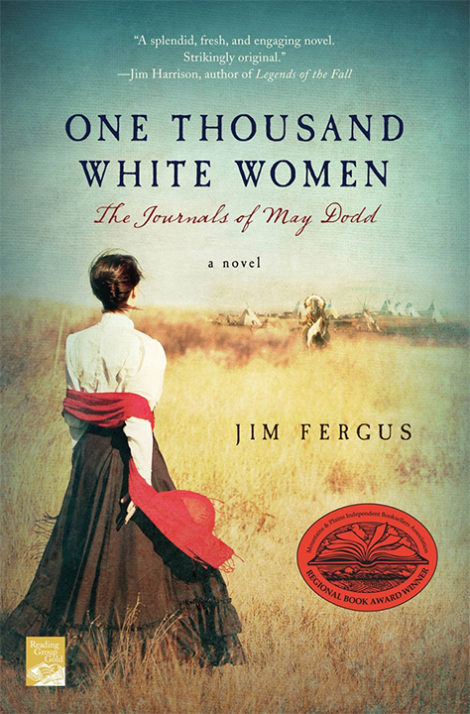
ONE THOUSAND WHITE WOMEN
The Journals of May Dodd
One Thousand White Women is the story of May Dodd and a colorful assembly of pioneer women who, under the auspices of the U.S. government, travel to the western prairies in 1875 to intermarry among the Cheyenne Indians. The covert and controversial “Brides for Indians” program, launched by the administration of Ulysses S. Grant, is intended to help assimilate the Indians into the white man’s world. Toward that end May and her friends embark upon the adventure of their lifetime. Jim Fergus has so vividly depicted the American West that it is as if these diaries are a capsule in time.
One Thousand White Women is the story of May Dodd and a colorful assembly of pioneer women who, under the auspices of the U.S. government, travel to the western prairies in 1875 to intermarry among the Cheyenne Indians. The covert and controversial “Brides for Indians” program, launched by the administration of Ulysses S. Grant, is intended to help assimilate the Indians into the white man’s world. Toward that end May and her friends embark upon the adventure of their lifetime. Jim Fergus has so vividly depicted the American West that it is as if these diaries are a capsule in time.
- St. Martin's Press
- Paperback
- February 1999
- 304 Pages
- 9780312199432
About Jim Fergus
 Jim Fergus is an award-winning writer whose work has appeared in numerous national magazines and newspapers. He is the author of several fiction and nonfiction books. Jim divides his time between southern Arizona, northern Colorado, and France.
Jim Fergus is an award-winning writer whose work has appeared in numerous national magazines and newspapers. He is the author of several fiction and nonfiction books. Jim divides his time between southern Arizona, northern Colorado, and France.
Praise
“It’s a superb tale of sorrow, suspense, exultation, and triumph that leaves the reader waiting to turn the next page and then wonderfully wrung out at the end.” —Winston Groom, author of Forrest Gump
“A most impressive novel that melds the physical world to the spiritual. One Thousand White Women is engaging, entertaining, well-written, and well-told. It will be widely read for a long time, as will the rest of Jim Fergus’s work.” —Rick Bass, author of Where the Sea Used to Be
“The best writing transports readers to another time and place, so that when they reluctantly close the book, they are astonished to find themselves returned to their everyday lives. One Thousand White Women is such a book. Jim Fergus so skillfully envelops us in the heart and mind of his main character, May Dodd, that we weep when she mourns, we shake our fist at anyone who tries to sway her course, and our hearts pound when she is in danger.” —Colorado Springs Gazette
Discussion Questions
1. The Cheyenne are often referred to as “savages,” even by the women who voluntarily travel to live among them. During this time period, what is it that makes the Cheyenne savage, and the white “civilized”? Are there ways in which you would judge the Cheyenne in the novel are more civilized than the whites? Are there ways in which you consider them less civilized?
2. Were you surprised that Little Wolf, the Cheyenne chief, was so aware and seemingly resigned to the fact that his culture was doomed? How does this differ from our attitudes and assumptions as United States citizens?
3. Did you admire May Dodd’s rebelliousness? Did you find it shocking that she would leave her children behind? Do you consider her a sympathetic character?
4. Did you find it believable that the US government might undertake a covert project such as the “Brides for Indians” program? Do you think the author had more modern history in mind when he developed this idea?
5. Were you surprised by elements of the Cheyenne Culture as depicted here?
6. Do you think that the Cheyenne culture was respectful of women? Consider what might seem contradictory elements – for example, it is a matrilineal society, and yet warriors could have multiple wives.
7. Compare what the Cheyenne culture valued in women compared with what white culture at the time valued in women. Contrast Captain Bourke’s fiancée, Miss Lydia Bradley, with May Dodd. In what way do May and Lydia represent different types of women? In what ways have cultural expectations of women changed since this time period, and in what ways have they remained the same?
8. Did you find it believable that the white women embraced the Cheyenne culture, and willingly married with them?
9. Compare your concept of romantic love, and married love, with the relationship that develops between May and Little Wolf.
10. Were you surprised by the violence among tribes as depicted here? Did it contrast with your understanding of Native American cultures? What similarities were there between the violence among tribes, and the violence between whites and Native Americans?
11. While depicting the slaughter of Native American culture, Jim Fergus also portrays the imminent decimation of the natural landscape. Consider both tragedies. Were they equally inevitable? Are they equally irreversible?
